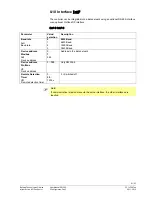
63/93
Building Technologies Division
User Manual RWF55...
CC1U7867en
Infrastructure & Cities Sector
9 Self-setting function
05.11.2013
The
tUnE
function uses 2 different methods that are automatically selected depending
on the dynamic state of the actual value and the deviation from the setpoint at startup.
tUnE
can be started from within any dynamic actual value sequence.
If there is a
great difference between actual value and setpoint
when
tUnE
is
activated, a switching line is established about which the controlled variable performs
forced oscillations during the self-setting process. The switching line is set to such a
level that the actual value should not exceed the setpoint.
X
7866d18e/1011
Switching
level
Figure 31: Great difference between actual value and setpoint
With a
small deviation
between setpoint and actual value (after the controlled system
has settled, for instance), forced oscillation about the setpoint is performed.
X
7866d19/0911
Figure 32: Small control deviation
The data of the controlled system recorded for the forced oscillations are used to
calculate the controller parameters
rt
,
dt
,
Pb1
and a filter time constant
dF1
for actual
value filtering that is optimized for this controlled system.
- High-fire operation in
modulating burner
mode
- The thermostat function (relay K1) must be constantly activated; otherwise
tUnE
will
be canceled and no optimized controller parameters will be adopted
- The above mentioned actual value oscillations during the self-setting process must
not exceed the upper threshold of the thermostat function (increase if necessary, and
lower the setpoint)
Note!
A successfully started
Self-setting
function is automatically aborted after 2 hours.
This could occur in the case of a controlled system that responds slowly, for example,
where, even after 2 hours, the described procedures cannot be successfully
completed.
2 procedures
Conditions
















































